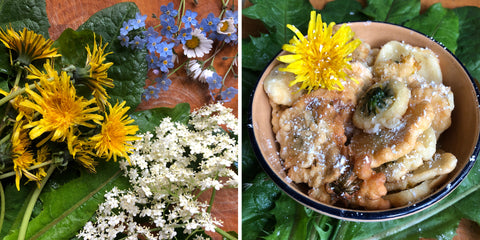Breaking news… weeds are to be ‘rebranded’! The well-renowned Royal Horticultural Society has announced that we are all now to welcome these ‘resilient plants’. In my gardening book, I’ve often turned a blind eye to some plants if they don’t spread themselves around too much and offer food to bees and other pollinators. So, I’m very pleased that this style of gardening is now acceptable, encouraged even, and all those previously unwelcome flowers can be valued and allowed their space. Many of these wild plants not only feed insects and birds but are also edible to humans. Incorporating them into our diets is something of a lost but very joyful art. Here are some ideas.
Wild flowers
In many cultures, albeit where the climate is consistently and reliably warmer, flowers are a regular feature in food (and tea!) – think jasmine, cherry blossom, ginger lily, butterfly pea. Away from the tropics there are still plenty of wild and cultivated flowers that can be added to food for visual appeal and unique flavours. Perhaps you’ve already gathered some wild garlic this year and made some tasty meals, decorated with delicate white flowers.
Campaigns like ‘No Mow May’ help to embed a more hands-off approach that allows wildflowers to emerge into a pretty smattering of many colours across the lawn. Not all are edible, you must be careful and sure, but wildflowers that you might find in and around the lawn that you could forage to sprinkle over salads or add to your sandwich are daisies, forget-me-nots, dandelion, clover and primrose. The leaves of the dandelion can be used as a substitute for spinach or kale as well has the leafy base of pesto. Their tendency towards bitterness is nicely offset by the other pesto ingredients. Cheese suddenly becomes the sweet element, and any toasted nuts or seeds you choose (pine nuts, cashews or pumpkin seeds) will round it all off deliciously.
Elderflower in the garden. Our XL Jugs can hold 2.5 litres of Elderflower cordial, saving you trips back into the kitchen.
One of the great all-round wildflowers is elderflower. After gathering whole in-full-bloom heads to make up a batch of cordial, you’ll be able to add it to all kinds of recipes. Elderflower flavour goes particularly well with gooseberries, as well as mixed into drinks – cocktails with spirits, fruit juices or to simply jazz up a glass of water. Any spare heads can be put into a bottle of vinegar, olive oil or vodka to flavour it. They can also be pickled in vinegar and used to garnish cooked meat, or, dipped in batter and fried.
Cultivated flowers
Pansies, violets and cornflowers, nasturtium and marigolds are all edible. Most herb plants have flowers that you can also use – thyme, mint, rosemary and chives (see our recipe below for lemon and rosemary drizzle cake) . Some are fragrant in flavour while others offer a hot and peppery bite, but they will all add wonderful colour and interest scattered over a salad or across the top of a cake. Flowers can be used whole or larger ones can be gently pulled apart into petal confetti.

Tempura-style, deep-fried dandelion flowers in batter served in our versatile Medium Bowl
Our friends in the Mediterranean make edible flowers the centrepiece. Courgette and squash flowers are scrumptious cooked tempura-style, deep-fried in batter either empty or stuffed with cheese. Try this also with whole dandelion flowers. Artichokes are another floral delicacy. Admittedly it’s not the fluffy ‘choke’ that’s edible, but the tender parts of the surrounding leaves and heart, once steamed, are fabulous (and oh so messy!) when dipped in lemony, salty and peppery garlic oil. Mmmm!

For something more aromatic we can turn to scented rose petals and lavender. These flowers can be added to cake or biscuit batters and will also impart their flavour when sprinkled across the top of shortbread or fairy cakes. The flowers and petals can be added to a pot of sugar in much the same way as a vanilla pod is kept in a sugar jar to generate a hint of fragrance. Keep the lavender on the stalks so it can be removed more easily when it’s time to use the sugar.
On that sweet note I will leave you so I can spend some time tending the dandelions.
Susan Mosse
Some words of advice:
- ALWAYS CHECK and be sure of what you are eating. Some plants are extremely poisonous.
- AVOID flowers that are right beside a busy road or that might have pesticides and other chemicals on them.
- ONLY pick what you need.
Lemon and rosemary drizzle cake
Lemon & rosemary drizzle cake on our Medium Rectangular Plate in Clematis, with our Medium Bowl Blue Blooms filled with zesty lemons. Our versatile Small Cylinder Jug in Wild Flower Meadow can double as a handy utensil holder.
This is a lemon drizzle cake with a twist! Bake your preferred lemon drizzle cake (we find Odlums lemon drizzle cake recipe super easy and efficient to bake) recipe.
For the lemon & rosemary syrup
- 4 sprigs of rosemary
- 2 tablespoons Granulated Sugar
- Juice of 1 Lemon
- 6 tablespoons of water
While the cake is baking, prepare the syrup. Combine all the ingredients into a small saucepan and bring to a boil. Turn the heat down and simmer gently for five minutes. Turn the heat off and leave the rosemary to infuse in the saucepan. When the cake is ready, prick the warm cake with a fork. Remove the rosemary and then gently drizzle syrup over until completely absorbed.
Serve on a Medium Rectangular Plate and enjoy with a cuppa in our new Large Mug Summer Daisy.



































